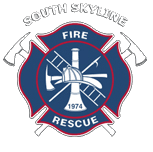Becoming a Volunteer
So, you'd like to become a Santa Cruz County Fire volunteer with Company 29, South Skyline Fire & Rescue. Great! There are a series of steps to go through prior to becoming a member.
First, here is a video from the 2012 Basic FireFighting Academy. You can click on the Pop-out icon in the upper right of the frame below if you want it in a separate tab and the ability to go full-screen. Below the video frame, we explain the details of our program.
Prerequisites
- You need to reside in our response area, which extends along Highway 35 from Bear Creek Road, north to the San Mateo County line, and south on Highway 9 to Highway 236.
- Be at least 18 years of age and in good physical condition.
- Have a current and valid drivers license or state photo identification.
Process
- Attend 3 company training sessions to meet the group, find out who we are, and ask questions.
- Complete and return the Volunteer Firefighter Application along with a current DMV printout and 2 letters of reference. The application is reviewed by the Company 29 officers and our battalion chief. If the application is approved, it is placed in a pending status.
- Attend an interview with a Company 29 officer and our battalion chief.
- Obtain a "Live Scan" background check.
- Complete and pass the CPAT (Candidate Physical Ability Test). The CPAT Testing Center is an indoor facility designed with the firefighter candidate in mind. Candidates receive an orientation and a rigorous, professionally run test covering eight basic skills. Additional information is located at the CPAT web site. We recommend that you watch the video under Preparing for the CPAT.
- After you have passed CPAT, your application will be submitted to the Santa Cruz County Fire training division.
- The training division will provide information for the scheduling of a pre-employment physical exam. Santa Cruz County Fire will pay all necessary fees.
Once all of those steps are successfully completed, you are covered by worker's compensation insurance, and you are part of the team! You will make an appointment with the Santa Cruz County Fire Warehouse to be fit for turnouts and wildland protective gear, and be fit-tested for an SCBA mask. You are also able to attend and participate in Company 29 training drills and you will be entered into the Volunteer Firefighter Academy!
Initial Training - Volunteer Academy
The Volunteer Academy is run from January through May on weekends and one or two weekday evenings. Though there are some breaks, there is little room for make-ups. The academy begins with a one day Safety and Orientation day. The academy is designed to prepare individuals for all aspects of the job as a volunteer firefighter.
- Structure topics include: general safety, basic fire chemistry and behavior, breathing apparatus, portable fire extinguishers, forcible entry, rescue, ladders, water supply, hose loads, fire streams, communications, salvage operations, ventilation techniques, and building construction. Some of this training is conducted at the company level during the course of the academy.
- Wildland topics include: terminology and safety, parts of a vegetation fire, fire shelters, handline construction, use of water on wildland fires, simple and progressive hose lays, mop-up, and chain saw safety and operations (S212).
- Haz Mat: This segment is designed to help students gain an improved capability to respond to Haz Mat events in a safe and competent manner, within the typical limited response resources and responder capabilities at the Operations levvel. This course also introduces students to decontamination procedures as well as the codes and procedures required in order to deal with confined space rescues.
- Auto Extrication is a hands-on experience in the procedures and systems utilized in automobile extrication including: hand/power tools; removing windows, doors, and roofs; raising dashboards; vehicle stabilization; simulated rescue of trapped victims.
- Low Angle Rope Rescue Operations (LARRO) is all about ropes and rescue systems. Raising, lowering, mechanical advantage, and securing patients to a backboard and litter are all topics in LARRO.
- ICS-100, ICS-200, and NIMS-700 are introductions to the Incident Command System. These are online classes and must be completed prior to most of the following modules.
- EMS: CPR for the professional rescuer is required. Sometimes this is part of an EMS class; sometimes not. The Red Cross provides this training, which is the better part of a day. Then, you will need to be certified to at least the PSFA (Public Safety First Aid) level for medical skills. This training is provided by Santa Cruz County Fire, usually in November or December prior to the academy. CPR is a one day class; PSFA runs around 40 hours. It is desirable to obtain an EMT certification. EMT is a more in-depth curriculum. Most local colleges offer a class once or twice a year, and there are private offerings as well. EMT can take half a year to complete.
Once you have completed this training, you are classified as a VFF 1 trainee. You will be issued a radio pager and you are able to respond to incidents in a supervised capacity.
The First Year+
Continuing education is a key part of our training. Your EMS skills must be recertified every 2 years. We use an online system to reinforce knowledge so that by the time various skills recertifications comes around, you have satisified the required hours of continuing education credits. This requires a few hours a month. We also drill at least twice a month.
Beyond Firefighter
You might consider becoming a Volunteer Engineer. This requires a number of classes, including the OSFM Driver Operator 1A/1B series, ICS-300, NIMS-800, OSFM Company Officer 2D, and S231 Engine Boss. Several of these are 5-day classes. There is also a considerable amount of required testing and time behind the wheel.

 | ©2012
| ©2012